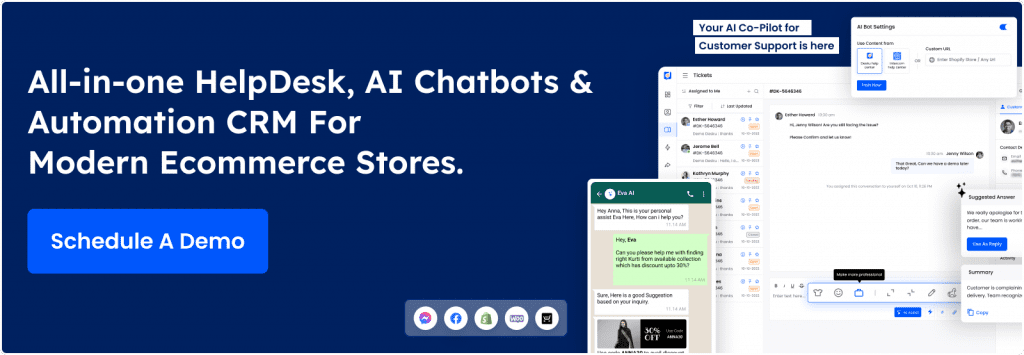Running an eCommerce business involves keeping track of numerous metrics, yet one you shouldn’t overlook is your churn rate. This vital indicator shows the number of customers who are deciding to leave your online store – possibly to shop with your competitors.
By understanding, tracking, and reducing the Ecommerce churn rate in 2024’s dynamic eCommerce environment, you can truly transform the success of your business. Stick around as we discuss how to minimize this often-overlooked threat and use it as a stepping stone towards business growth and customer loyalty.
Aren’t you eager to learn how to keep your customers connected to your brand?
What is Churn?
The term ‘churn’ might sound complex, but it’s pretty simple. Imagine you have a business, maybe an online subscription service. Now, think about a customer who suddenly stops buying from you. That’s what we call ‘churn’ in the ecommerce world. It’s just a fancy term for when customers stop their shopping spree with your business.
Okay, so we’ve got churn down, but what about ‘churn rate’? Well, this is just a way of measuring churn. It tells you how many customers you’ve lost over a certain period.
If you have a high rate of churn, you might want to sit up and pay attention. It could mean there are issues with your product or it’s not making your customers happy.
The higher the churn rate, the more customers you’re saying goodbye to.
But don’t worry, it’s not all bad news. Getting to grips with churn can be a good thing for your ecommerce business. It’s like having a secret weapon. You can figure out why customers are leaving and fix the problem.
Plus, did you know that if you just increase your customer retention by 5%, you could see your profits go up by more than 25%? So, understanding churn isn’t just about stopping the loss of customers. It’s also a powerful way to boost your profits.
Key Takeaway :
To measure and reduce the churn rate in ecommerce in 2024, businesses can use strategies such as segmenting customers for targeted engagement, collecting feedback and ratings, offering omnichannel customer service, introducing loyalty programs, implementing systems to stop involuntary churn, improving post-purchase experiences, and encouraging exchanges instead of returns. These strategies can help businesses retain customers and reduce the impact of churn on their revenue and profits.

The Importance of Understanding Churn in Ecommerce Business
Understanding the Churn rate in an ecommerce business is one of the important tasks, as it is directly proportional to the success of your business.
- Importance of Measuring Churn Rate in Ecommerce:
- The churn rate is crucial for understanding how many customers stop buying products over a certain period.
- It helps in gauging customer retention and loss.
- Calculating Churn Rate:
- To calculate the churn rate, determine the percentage of customers who stopped buying compared to the total customer base over a specific period.
- Strategies to Reduce Churn Rate:
- Providing personalized experiences and exceptional service can help in retaining customers.
- Making customers feel valued and taken care of increases their likelihood of remaining loyal.
- Benefit for Ecommerce Business:
- Reducing churn and enhancing customer retention is advantageous for the growth and profitability of an ecommerce business.
Impact of Customer Retention
A small increase in customer retention (5%) can lead to a significant increase in profit (over 25%).
How to Calculate Churn Rate?
If you run an ecommerce business, you’ll know that keeping tabs on your churn rate is crucial. So, what’s the secret to calculating it?
It is simply about knowing and keeping track of the customers who have left your business to competitors.
Here’s a simple formula👇🏻
Churn Rate= (Total Lost Customers/Customers in the period) x 100
Churn can be tracked over various periods, such as monthly, quarterly, or annually. A monthly churn rate offers insights into short-term trends, whereas an annual churn rate provides a more comprehensive view of customer loyalty and turnover over an extended period.
Though it might appear straightforward, the method of calculating churn depends on how subscribers and new activations are accounted for during the period under review. Some businesses count the number of customers at the start of the period, others at the end, or some may calculate an average.
This variance in definitions can complicate churn analysis, particularly for businesses experiencing a high influx of new customers. Consider an example where identical customer activities across two different months result in markedly different churn rates.
Calculating Annual Churn Rate
The annual churn rate is nothing but the calculation of the lost customers annually. Comparing the two years of the churn you can get an idea of the churn rate annually.
Example: 1k customers at the begging of the year and customers are decreased to 700-800 by end of the year. So,
(1000-800)/1,000 x 100= annual churn rate
200/1,000 x 100=20
The annual churn rate is 20%
A simple math!
Calculating Monthly Churn Rate
It’s simple, the monthly churn rate is calculating the customers lost over the month. You don’t need to get new customers every time, you may or may not get it. Sometimes, there are chances to lose it completely.
For example, 100 customers lost out of 800 customers monthly
(100/800) x 100 = monthly churn rate
0.125 x 100 = 12.5
The monthly churn rate is 12.5%
What is the Revenue Churn Rate?
The revenue churn rate is the calculation of the revenue lost because of customer churn, and total revenue generated by the business during a particular time.
But, how to calculate the revenue churn rate?
Revenue churn rate = Revenue lost due to customer churn/ total revenue generated) x 100
For example, a $1 million value generated in a month but customers were lost $100,000 due to customer churn, so the churn rate is calculated as follows;
Revenue churn rate= (100,000 / 1,000,000) 100
Revenue churn rate =(0.1) x 100
Revenue chrun rate = 10%

7 Ways To Reduce Ecommerce Churn Rates
Keeping your ecommerce churn rates low is key to ensuring your business continues to thrive. How about slicing and dicing your customer base into neat segments? This allows you to whip up bespoke strategies that hook in the right folks at just the right moment.
Receiving frequent feedback from your customers is another great idea – they’ll appreciate that you value their opinions. Plus, having top-of-the-line customer service at the ready, launching awesome loyalty programs, and promptly handling any involuntary churn can go a long way in keeping your customers happy and loyal.
Let’s understand the top 7 ways of understanding ways to reduce the churn rate in the ecommerce business.
1) Segmenting customers for the right engagement
Various types of customers will contact your business some with genuine and legit problems, and some with very casual problems. It is important to keep customers segmented.
You can segment customers according to;
👉🏻 Queries they create
👉🏻 Products or services they avail
👉🏻 Quantity of the product that they are purchasing
👉🏻 Other factors (according to business)
The segmented customers will help you to differentiate it to send accurate and targeted advertisements, relevant messages, tailored support, and any relevant offers they want to provide to customers.
It becomes easier to send the targeted emails to customers. For example, some of the customers might not need the marketing emails but you can send emails to some visitors who are yet to make a purchase.
2) Collect Feedback and Ratings From Customers
Understanding the customers is the core part that helps to elevate the business and brings sustainable success. Collecting feedback is one of the easiest ways to keep a check on how and what customers think and feel about your company. Know the expectations of your customers through running CSAT.
💡Tip: If you want honest feedback, engage with regular and recurring customers of your company, they will always provide the direct answers through which you can make changes accordingly.
If you use Desku, there is an automated way to send the CSAT surveys through emails and live chat with customers. It can be sent after every interaction with a customer support agent or for example after a purchase of any products purchased from you.
3) Omnichannel for Better Customer Service Experience
Omnichannel means, to be available on the platforms where your customers are, such as most of the social media channels. A strong and direct engagement with where your customers are will serve them a better customer experience.
The key is to create a smooth customer experience across all platforms, which can help keep customers engaged and decrease churn.
So, what should you do?
- Set up a strong customer support system that can be accessed through various channels. Think social media, email, live chat, and the like.
- Be one step ahead with your customer service. Try to figure out what your customers might need and address those needs before they even become a problem.
- Keep your customers hooked with personalized interactions and quick responses.
These tactics aren’t just effective in retaining customers but also in reducing your eCommerce churn rate. And let’s not forget, a satisfied customer is more likely to stick around, which can help cut down customer churn and bump up your profits.
Sounds like a win-win, doesn’t it?
4) Introduce loyalty-building campaigns and strategies
Let’s chat about how you can make your eCommerce business more sticky and keep your customers coming back for more.
👉🏻 How can you do this? Well, one way is by kick-starting some campaigns and strategies aimed at building loyalty.
👉🏻 Why does this matter? Because customer loyalty is a big deal when it comes to keeping your customer base and boosting your retention rate.
Think about starting a loyalty program. This can be a great way to get your customers excited about shopping with you again and again. It also helps to build a level of trust with your brand.
Consider giving out rewards for customer interactions and purchases. This not only makes the shopping process more enjoyable but also encourages customers to stay engaged with your brand for the long haul.
And let’s not forget the power of user-generated content. Including this as part of the shopping experience can amp up the trust factor. It’s a simple way to make your eCommerce store more secure against customer churn.

5) Implement Systems to Stop Involuntary Churn
Reducing involuntary churn in your eCommerce business is often a matter of creating an open and honest subscription cancellation process. This method can help keep your customers around longer by giving them more control over their subscriptions. However bear in mind, it’s not all about making cancellations straightforward.
You could also:
👉🏻 Predict potential churn using data analysis and then act to prevent it.
👉🏻 Provide unique incentives or price cuts to customers who might be thinking about leaving.
👉🏻 Put customer support strategies in place to handle issues before they result in churn.
Keeping a close eye on your churn rate can help you spot patterns and work out where you need to improve. A high churn rate is a sign of unhappy customers, so always aim to make your eCommerce customers’ experience better.
6) Improve your post-purchase experience
Think about it, if you want to keep your online shoppers coming back, it’s super important to make sure they’ve a great experience, not just while they’re shopping, but even after they’ve made a purchase. That post-purchase experience can sway how a customer feels about your business.
So, what can you do to make that experience better? Well, for starters, try recommending products to your customers that suit their needs. It shows them that you understand them and care about their experience.
Lastly, don’t shy away from asking for feedback. It can give you a real insight into what you’re doing right and where you need to step up your game. Trust me, being open to criticism and making necessary changes can help you hang onto your customers and stop them from heading elsewhere.
That’s the long and short of it. By paying attention to these small details, you can make sure your customers stick around and keep shopping with you.
7) Encourage Exchanges Instead Of Returns
Reducing your ecommerce churn rate mightn’t be as tricky as it seems. One good strategy is to switch gears from focusing on returns to promoting exchanges. This way, you won’t lose customers who mightn’t be completely happy with their purchase. Instead, gently nudge them to swap their item for another that might be a better fit for them.
Keep in mind that a smooth, hassle-free exchange process is key. It can help keep your customers content and more likely to stick around.
Think about throwing in a little extra to sweeten the deal. Perhaps a discount on their next purchase? This can be a great way to motivate your customers to go for an exchange rather than a return.
Lastly, don’t forget to use those valuable insights you get from returns. They can help you fine-tune your product descriptions to ensure they match what the customer is expecting. This way, you can avoid any future mismatches and keep your customers satisfied.
Also Implementing effective revenue increase tactics can help reduce churn rate in ecommerce businesses. Providing personalized shopping experiences, offering subscription-based services, and improving customer service can all contribute to increased customer retention
Related Article:10 Best Tips on How to Reduce Returns in E-Commerce [Stats and Best Practices]

How Does Churn Affect Your Ecommerce Business?
Grasping how to figure out your churn rate is one thing, but understanding how it impacts your eCommerce business is a whole different ball game. A high churn rate can put a serious dent in your overall revenue and profits.
Why, you ask? Well, the churn rate in eCommerce gives you the cold, hard numbers of customers who’ve stopped using your product within a certain period. This directly affects how many customers you retain and, by extension, your business’s performance.
Here’s a quick fact to wrap your head around: if you manage to retain just 5% more customers, you could see your profits shoot up by a whopping 25%! This little nugget of data goes to show how big a role churn plays in your bottom line.
A high churn rate could lead to financial difficulties, a dip in customer loyalty, and the worst-case scenario, even cause your business to shut down. So, it’s pretty clear that coming up with ways to cut down the churn rate and keep a healthy customer base is key to growing your business.
It’s also worth noting that churn rates can vary greatly depending on the industry and the type of product. So, it’s a good idea to know what the average churn rates are in your specific field, as this can give you a yardstick to measure your business’s performance against.
Paying attention to the details and working smart to measure and reduce your eCommerce churn rate can go a long way in ensuring your business thrives in the long run.
What Does a Healthy Churn Rate Mean for You?
A business can never be 100% churn and hence a small amount of churn does not affect the business that much and it is considered to be healthy as well in any business. You might be wondering how?
So, what’s the deal with a healthy churn rate and why should it matter to you? Well, in the world of ecommerce, a churn rate is like a pulse check on your customer retention and loyalty. Range from 2-8% in any B2C or SaaS company is acceptable and considered to be a healthy churn rate.
Ideally, you want your churn rate to be lower than 10%. Anything less than this means you’re not just retaining customers, but they’re also likely to refer their friends to shop at your store. The more referrals you get, the more it boosts your business’s profitability and customer lifetime value. It’s like having a loyal fan base who keeps coming back for more.
In 2024, ecommerce tool recommendations can help businesses reduce churn rate by offering personalized product recommendations, streamlining the checkout process, and providing excellent customer support. With the right tools in place, businesses can analyze customer behavior and preferences to create a better shopping experience, ultimately reducing churn rate.

Conclusion: Reduce the Churn Rate and Elevate the Revenue and Success
Calculating the churn rate is simpler, but we all have to take care and focus on reducing the churn rate in the business. From monthly to yearly, calculate the churn rate and know what and how you can focus on improving the churn rate and ultimately decreasing the churn rate over time.
We believe that as your brand grows, your customer base is rapidly increasing it is important to keep up with the customer engagement. With Desku.io, you can optimise the whole conversation under the unified inbox, real-time live chat for quick customer engagement, no-code chatbot builder for automating conversation, and much more.
Implement the best strategies and reduce the churn rate.
Frequently Asked Questions
What is Churn in eCommerce?
Churn in eCommerce refers to customers who stop purchasing from an online store, indicating a loss of business to competitors. It’s a measure of customers discontinuing their shopping relationship with a business.
How Do You Calculate Churn Rate in eCommerce?
The churn rate in eCommerce is calculated using the formula: Churn Rate = (Total Lost Customers / Customers at the Start of the Period) x 100. This metric can be tracked monthly, quarterly, or annually to understand customer retention and loyalty.
What Strategies Can Reduce eCommerce Churn Rates?
To reduce eCommerce churn rates, businesses can segment customers for targeted engagement, collect feedback and ratings, offer omnichannel customer service, introduce loyalty programs, implement systems to stop involuntary churn, improve post-purchase experiences, and encourage exchanges instead of returns.





